
Collected
A magnitude 7.8 earthquake hit southern Turkey and northern Syria early Monday, toppling hundreds of buildings and killing more than 2,300 people. Hundreds were still believed to be trapped under rubble, and the toll was expected to rise as rescue workers searched mounds of wreckage in cities and towns across the area.
On both sides of the border, residents jolted out of sleep by the predawn quake rushed outside on a cold, rainy and snowy winter night. Buildings were reduced to piles of pancaked floors, and major aftershocks continued to rattle the region.
Rescue workers and residents in multiple cities searched for survivors, working through tangles of metal and giant piles of concrete. A hospital in Turkey collapsed, and patients, including newborns, were evacuated from a handful of medical facilities in Syria.
In the Turkish city of Adana, one resident said three buildings near his home collapsed. “I don’t have the strength anymore,” one survivor could be heard calling out from beneath the rubble as rescue workers tried to reach him, said the resident, journalism student Muhammet Fatih Yavuz.
“Because the debris removal efforts are continuing in many buildings in the earthquake zone, we do not know how high the number of dead and injured will rise,” Turkish President Recep Tayyip Erdogan said. “Hopefully, we will leave these disastrous days behind us in unity and solidarity as a country and a nation.”
The quake, which was centered on Turkey’s southeastern province of Kahramanmaras, was felt as far away as Cairo. It sent residents of Damascus, the Syrian capital, rushing into the street, and jolted people awake in their beds in Beirut.
The temblor struck a region that has been shaped by more than a decade of civil war in Syria. On the Syrian side, the swath affected by the quake is divided between government-held territory and the country’s last opposition-held enclave, which is surrounded by Russian-backed government forces. Turkey, meanwhile, is home to millions of refugees from that conflict.
The opposition-held Syrian regions are packed with some 4 million Syrians displaced from other parts of the country by the fighting. Many of them live in buildings that are already wrecked from past bombardment. Hundreds of families remained trapped in rubble, the opposition emergency organization White Helmets said in a statement.
Strained health facilities and hospitals were quickly filled with injured people, rescue workers said. Others had to be emptied, including a maternity hospital, according to the SAMS medical organization.
Turkey sits on top of major fault lines and is frequently shaken by earthquakes. Some 18,000 people were killed in powerful earthquakes that hit northwest Turkey in 1999.
The U.S. Geological Survey measured Monday’s quake at magnitude 7.8. Hours later, a magnitude 7.5 temblor struck more than 60 miles away. Orhan Tatar, an official from Turkey’s disaster management agency, said it was a new earthquake, not an aftershock, though its effects were not immediately clear. Hundreds of aftershocks were expected after the two temblors, Tatar told reporters.
Thousands of buildings were reported to have collapsed in a wide area extending from the Syrian cities of Aleppo and Hama to Turkey’s Diyarbakir, more than 200 miles to the northeast. A hospital collapsed in the Mediterranean coastal city of Iskanderoun, but casualties were not immediately known, Turkish Vice President Fuat Oktay said.
Televisions stations in Turkey showed screens split into four or five parts, with live coverage from rescue efforts in the worst-hit provinces. In the city of Kahramanmaras, rescuers pulled two children alive from the rubble, while others tried to reach a relative.
Offers of help — including search-and-rescue teams, medical supplies and money — poured in from dozens of countries, as well as from the European Union and NATO.
The damage evident from photos of the affected areas is typically associated with a significant loss of life — while bitterly cold temperatures and the difficulty of working in areas beset by civil war will only complicate rescue efforts, said Steven Godby, an expert in natural hazards at Nottingham Trent University.
In Turkey, people trying to leave the quake-stricken regions caused traffic jams, hampering efforts of emergency teams trying to reach the affected areas. Authorities urged residents not to take to the roads. Mosques around the region were being opened up as a shelter for people unable to return to damaged homes amid temperatures that hovered around freezing.
In Diyarbakir, hundreds of rescue workers and civilians formed lines across a mountain of wreckage, passing down broken concrete pieces, household belongings and other debris as they searched for trapped survivors, while excavators dug through the rubble below.
In northwest Syria, the quake added new woes to the opposition-held enclave centered on the province of Idlib, which has been under siege for years, with frequent Russian and government airstrikes. The territory depends on a flow of aid from nearby Turkey for everything from food to medical supplies.
The opposition’s Syrian Civil Defense described the situation in the rebel-held region as “disastrous,” adding that entire buildings had collapsed and people were trapped under the rubble.
In a hospital in Darkush in Idlib, Osama Abdelhamid said most of his neighbors died. He said their shared four-story building collapsed just as he, his wife and three children ran toward the exit. A wooden door fell on them and acted as a shield.
“God gave me a new lease on life,” he said.
In the small Syrian rebel-held town of Azmarin in the mountains by the Turkish border, the bodies of several dead children, wrapped in blankets, were brought to a hospital.
The directorate-general of antiquities and museums in Syria said the earthquake had caused some damage to the Crusader-built Marqab, or Watchtower Castle, on a hill overlooking the Mediterranean. Part of a tower and parts of some walls collapsed.
In Turkey, the quake damaged a historic castle perched atop a hill in the center of the provincial capital of Gaziantep, about 20 miles from the epicenter. Parts of the fortress walls and watch towers were leveled and other parts were heavily damaged, images from the city showed.
Nearly 1,500 people were killed in 10 Turkish provinces, with some 8,500 injured, according to the country’s disaster management agency. The death toll in government-held areas of Syria climbed to more than 430, with some 1,280 injured, according to the Syrian Health Ministry. In the country’s rebel-held northwest, groups that operate there said the death toll was at least 380, with many hundreds injured.
Huseyin Yayman, a legislator from Turkey’s Hatay province, said several of his family members were trapped under the rubble of their collapsed homes.
“There are so many other people who are also trapped,” he told HaberTurk television by telephone. “There are so many buildings that have been damaged. People are on the streets. It’s raining, it’s winter.”
Source Los Angeles Times







